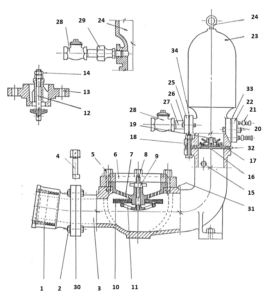How do I service my water pump and what parts might I need?
Blake Hydram Servicing
Blake Hydram Servicing & Troubleshooting
On completion of installation the operator should ensure that the Hydram is firmly bolted to its concrete base, and check that the drivepipe has been laid evenly.
The following procedures should then be applied:
- First before starting a Hydram we recommend the supply to the drive pipe is closed and the waste valve removed. Installers should open the valve on the drive pipe for a few minutes to allow the Hydram to be well flushed. When this has been done, then shut off the supply and replace the waste valve.
- Secondly you start the Hydram by opening the valve on the drive pipe. Usually the Hydram will start pulsating. If this does not happen, the rubber clack may be pushed open. Insert a blunt iron or steel rod through one of the perforations of the waste valve seat. Where a metal clack is fitted it may be opened by pushing down on the top of the metal clack spindle. If the rising main is empty you may need to repeat the above procedure.
- Thirdly the quantity of water taken to drive the Hydram can be regulated as follows:
- Where a rubber clack is fitted to the waste valve the consumption/delivery may be reduced from the rated maximum if you turn the wheel shaped guard closer up the waste seating. This will cause the Hydram to beat faster. This adjustment is made by loosening the locknut on top of the valve spindle and turning the spindle with a spanner. Make sure you tighten the locknut before the Hydram is started.
- Where the waste valve is fitted with a metal mushroom shaped clack the length of the stroke may be varied by means of the two brass locknuts on the valve spindle. The stroke may vary from 1/16” to ¼”. Also the shorter the stroke, the less water the Hydram will require, the less it will deliver, and faster pulsating.
You should adjust the waste valve so that there is at least a slight overflow at the intake. Or to the feed well to make sure you are not overrunning the supply.
In times of water shortage it is preferable to operate the Hydram continuously. On a quick stroke rather than intermittently on a slow one. Also you will save trouble and pump up more water in the long run.
N.B. (No branches)
No branches should be taken from the rising main to deliver water at a level lower than about three times the working fall. Otherwise the Hydram may stop each time the water is drawn through any such branches. Branches may be taken from higher points on the rising main, and should be controlled by ballcocks.
When a stop valve is fitted on the drive pipe close to the Hydram, the valve should be fixed in a horizontal or oblique position. To ensure no pockets of air will form in the valve mechanism.
Spare rubber clacks should be kept in a cool dark place. For spare part prices please contact us at info@greenandcarter.com
| Item Number | Description |
|---|---|
| 1 | Injection Socket |
| 2 | Bolt, Nut & Washer for Injection Socket |
| 3 | Ram Body |
| 4 | Waste Valve HD Bolt |
| 5 | Waste Valve Stud & Nut |
| 6 | Waste Valve Cover |
| 7 | Waste Valve Seating |
| 8 | Shutter Guard Spindle |
| 9 | Waste Valve Lug Nut |
| 10 | Waste Valve Clack (Rubber)* |
| 11 | Shutter Guard |
| 12 | Waste Valve Mushroom Clack |
| 13 | Waste Valve Seat & Cover |
| 14 | Brass Locknuts for Clack |
| 15 | Air Valve |
| 16 | Delivery Valve Seat |
| 17 | Delivery Valve Disc* |
| 18 | Air Vessel Flange Bolt, Nut & Washer |
| 19 | Star Nut or Saucer |
| 20 | Air Vessel Door Bolt or Stud & Nut |
| 21 | Air Tap |
| 22 | Air Vessel Door |
| 23 | Air Vessel |
| 24 | Air Vessel Eyebolt |
| 25 | Delivery Pipe Flange |
| 26 | Delivery Flange Bolt, Nut & Washer |
| 27 | Nipple |
| 28 | Back Pressure Valve (screwed) |
| 29 | Delivery Pipe Union |
| 30 | Socket Flange Joint Ring |
| 31 | Waste Valve Joint Ring |
| 32 | Delivery Valve Joint Ring |
| 33 | Air Vessel Door Joint Ring |
| 34 | Delivery Flange Joint Ring |
